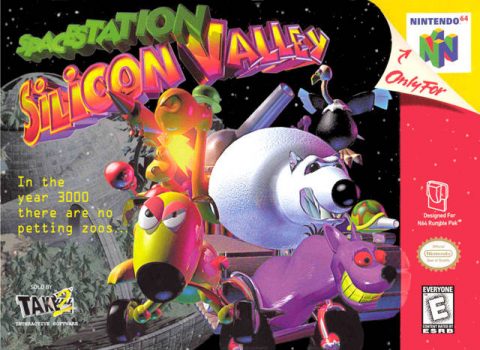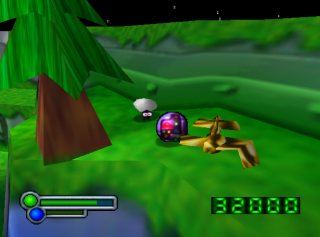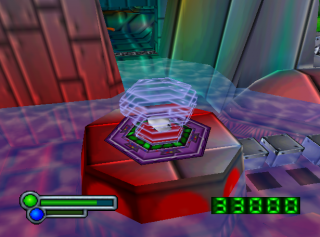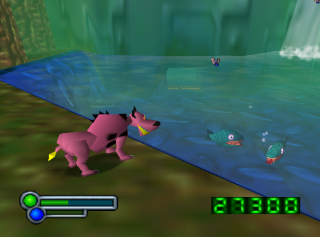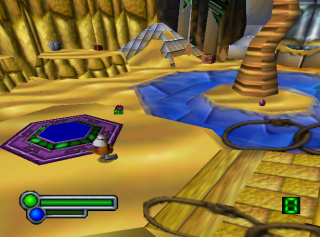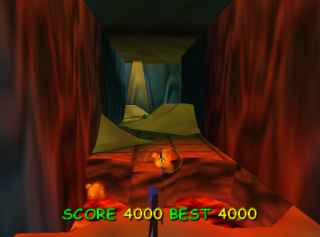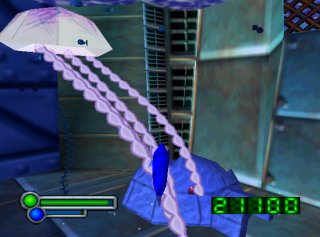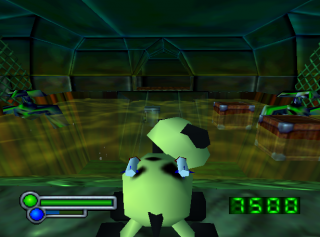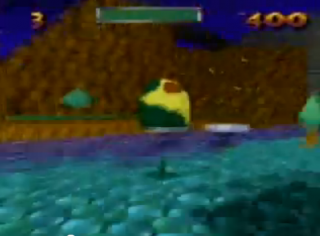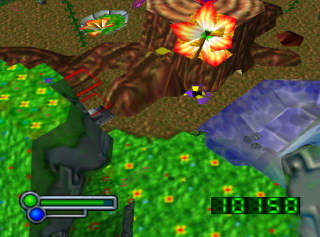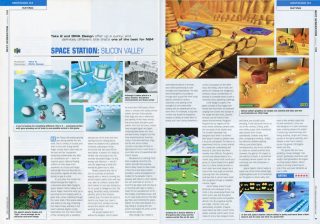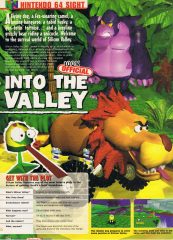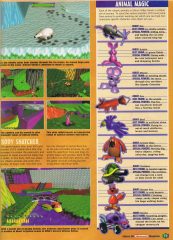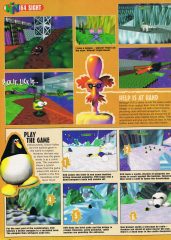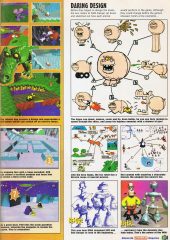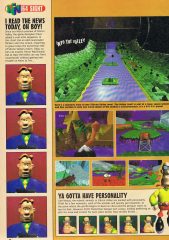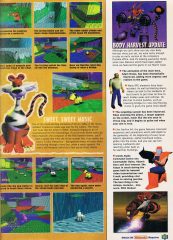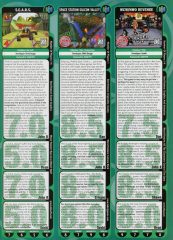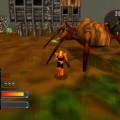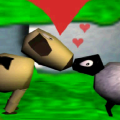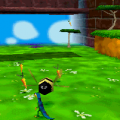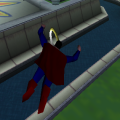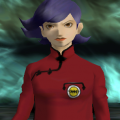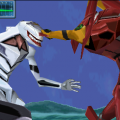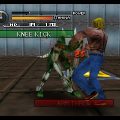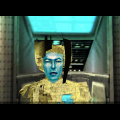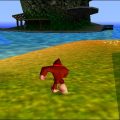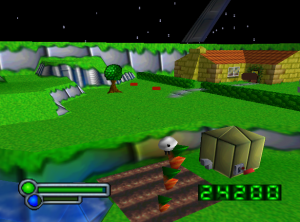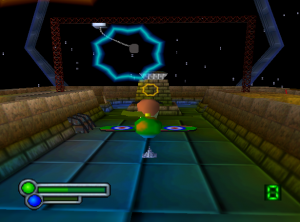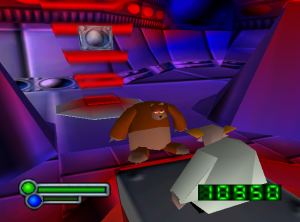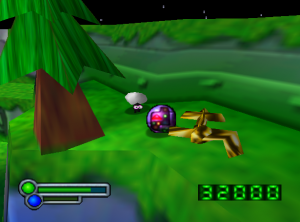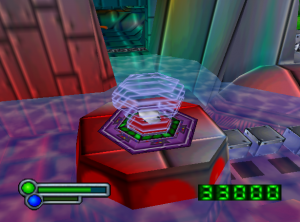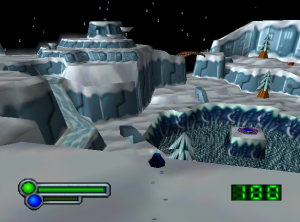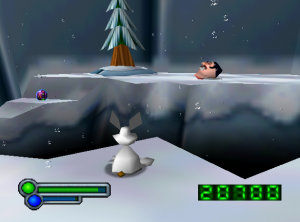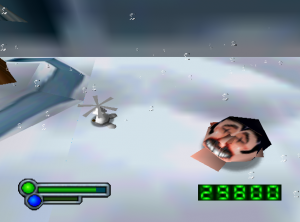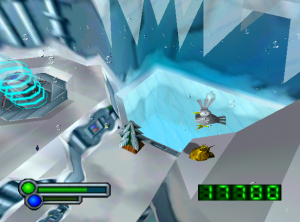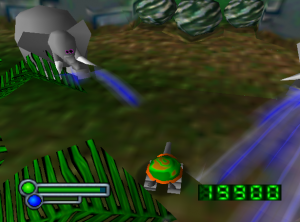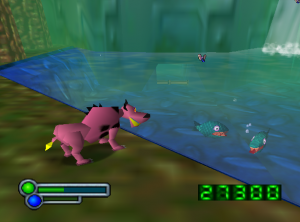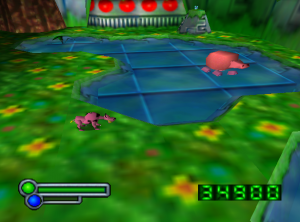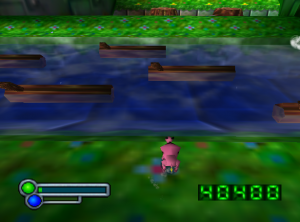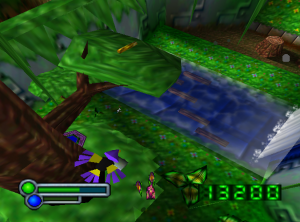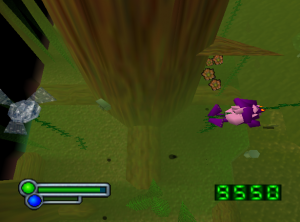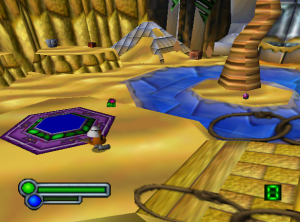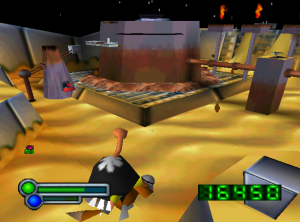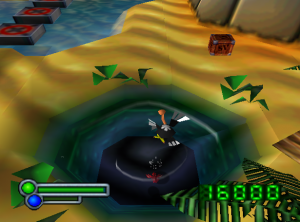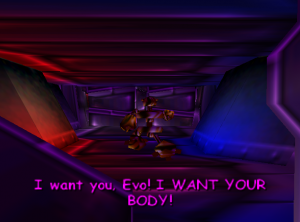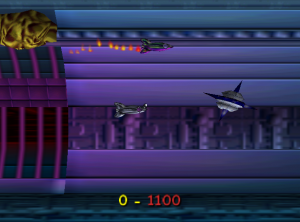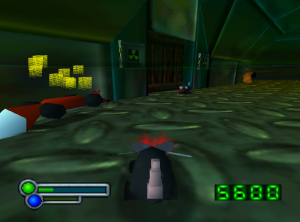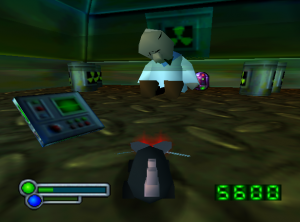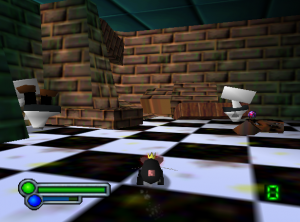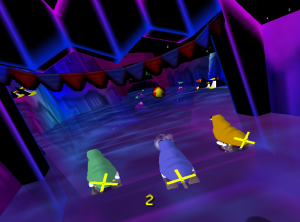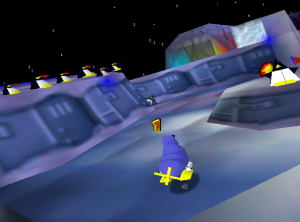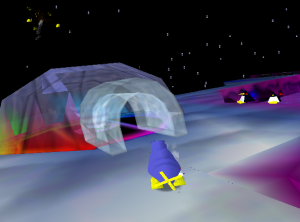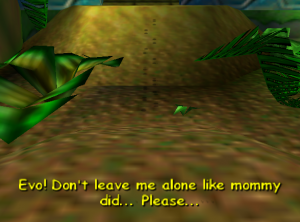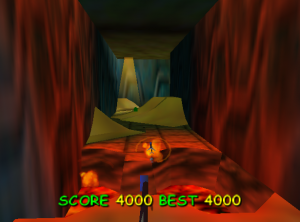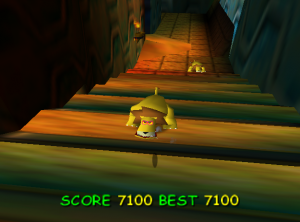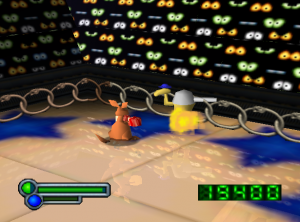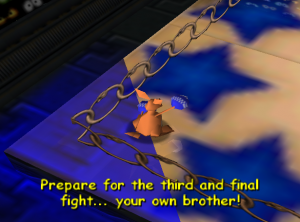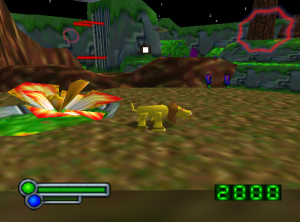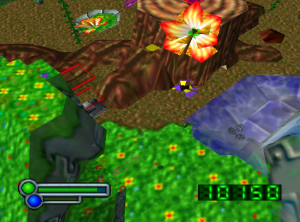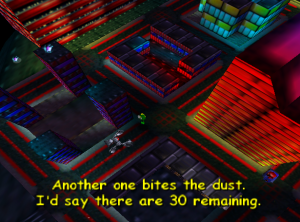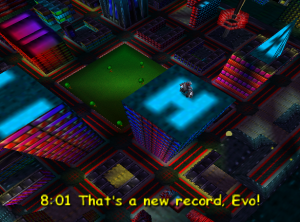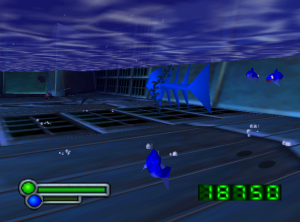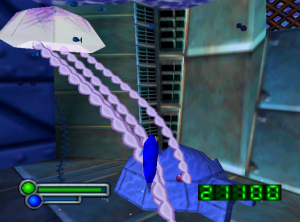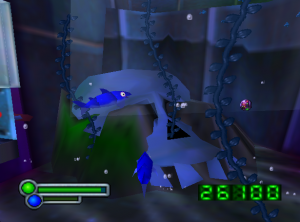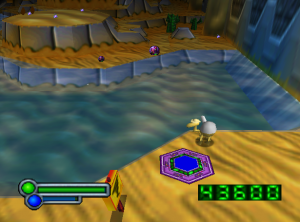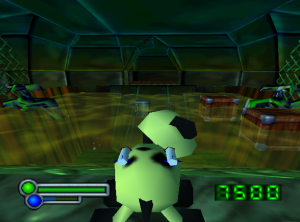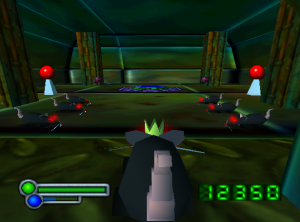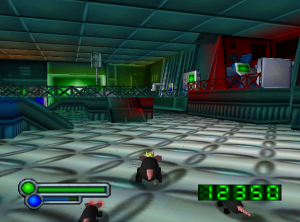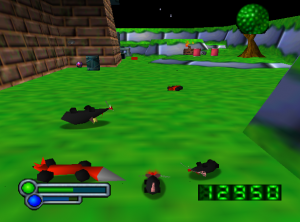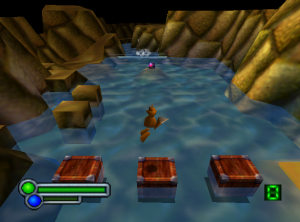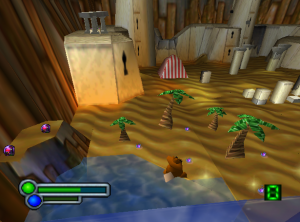- SpaceStation Silicon Valley
- SpaceStation Silicon Valley (Game Boy Color)
- Evo’s Space Adventures
Every generation sees a handful of wildly original games which forge new ideas, or rework old ones in such a way as to revitalize the concept. For a system with comparatively few games, the N64 was blessed with a rich catalog of originality. There was Blast Corps, a destruct-em-up which has no equivalent; Pilotwings 64, which turned the flight-sim into a whimsical adventure complete with birdmen; and SpaceStation Silicon Valley by DMA Design, which tasked you with possessing the bodies of dead robotic animals aboard a space station in the year 3000, and using their unique powers to solve puzzles. It was incredible, applauded by critics at the time, and spawned two ports (or rather a port and a remake), but no sequel.
Body possession in games is a fantastic though underused mechanic. The basic concept is that you are able to take control of enemies and/or NPCs within a game’s environment, to make use of their abilities and affiliations. In the right hands it should make use of multiple design sensibilities, allowing players to become empowered and play the world off against itself. So sublime are the possibilities, that describing it as a mere “mechanic” undervalues it. It really deserves to be regarded as a full blown genre, encompassing multiple genre subtitles, and sitting alongside classifications such as MMORPG, kusoge and shmup.
Braybrook’s Paradroid on C64 and Jaleco’s Avenging Spirit for arcades (and later GB) both made use of body possession and precede SSSV, but DMA Design’s tremendous creativity with the concept makes their offering extra special. Ironically, as explained by one of the game’s creators, SSSV‘s main influence was not games which came before, but rather the nascent Grand Theft Auto and Body Harvest, both also being worked on at DMA Designs at the time – it was the jumping in and out of vehicles which inspired the animal switching. Further excellent body possession games have followed, notably DoubleFine’s Stacking, but if you have any interest in the genre, it’s worth tracking down SSSV, which still stands as one of the shining examples of what can be done.
In the year 2001 Earth builds the largest, most expensive, luxurious and dangerous space station ever. Its name: Silicon Valley. Its purpose: to research artificial life and robotic evolution. The only problem: precisely seven minutes after launching, the space station mysteriously vanishes. Completely. Utterly. Absolutely. Gone. A massive search begins, but nothing is ever found. Fast forward 1000 years and it suddenly appears, as mysteriously as it had left, passing Uranus. Earth sends a squadron of brave Space Marines who promptly vanish. In fact they send five squads who all vanish. What this job needs is someone expendable and cheap – and so enters the bumbling and sociopathic Dan Danger, and his long-suffering servant EVO, a super-intelligent, self-evolving robot.
On the station, however, oblivious to the Earth government’s plans, a forbidden special kind of love is forming between a robot dog named Roger, and a robot sheep named Flossy. It breaks all the social and evolutionary conventions, and yet it feels so right. After Flossy requites his affections, Roger the dog does a little of dance of happiness, because yes, she does indeed love him too. And then Roger is crushed by Dan Danger’s enormous space ship. “ROGER! NOOO!” screams Flossy, but all the woolly tears in the universe can’t re-animate his dead body (or can they?). For you see, unfortunately, en route to the space station, Dan was busy fiddling with his intergalactic radio rather than watching where he was flying, and so promptly crashed right into it. EVO ends up ejected and smashed into pieces, while his control chip lands in the body of Roger, thereby possessing him (because all the animals on the station are robots). Flossy runs in fear! Roger the possessed dog chases after her, bites her to death, and then places her body near the exhaust of the crashed ship to be burned by fire! Suddenly a golden souvenir appears!
As the instruction manual states: SpaceStation Silicon Valley – it’s a Silly Place!
The game is divided between four main zones: European (woodland, farms, etc), Ice, Jungle and Desert, which are all self explanatory. Each of these is sub-divided into 10, 7, 6 and 7 levels respectively, in addition to the final confrontation and a secret bonus area, for a total of 32 levels. Progression is simple: every level has a teleportation pad and a number of mission objectives, and completing the objective activates the teleporter. This is where the fun begins!
Each zone has its own unique menagerie of creatures, each with their own unique powers. Europe has rats which release explosive poop, the arctic levels have helicopter rabbits which drop bombs, the jungle has pink hyenas which laugh enemies to death (no, seriously), and in the desert you’ll find boxing kangaroos which incredibly high jumps. The diversity of characters and their special abilities is phenomenal. Admittedly some overlap, since there are several creatures which can fly, but it feels like every second level you’re being empowered with some new skill.
Even more impressive is the exceptional diversity of mission objectives. This cannot be stated enough, but the team behind SSSV really went out of their way to make every single level feel special, with scarcely any repetition of action. So many games designers fall back on the old idea of collecting a specific number of something, or killing a specific number of something, and while some missions do incorporate these elements (often in unusual ways, such as collecting the scientist heads), the majority of objectives are wildly different. It’s actually a little bit sad when you consider the money, time and effort put into other games, especially those today, which provide players with an identical experience and the same set of actions from start to finish, over 40 hours, while something like SSSV manages to make every minute feel different to the next, while simultaneously maintaining a coherent style and atmosphere.
An early level will see you using a dog to herd sheep into a pen, using the sheep to float across islands, while in a later level that same dog is used to kill rocket foxes while the sheep grow carrots in a field to be used as platforms. In the Ice Zone a penguin will play music on an enormous piano in one level, or hunt down polar bears in another. What about a hyena playing a game of Frogger on some jungle logs, or a purple gorilla swinging from vines in a similar environment? Quite a few mission objectives are your standard “become this animal” variety, but the majority are extremely inventive and clever, possessing more creativity in a couple of levels than some developers will manage in an entire series of games. There are also no traditional boss levels, and instead the end of each zone features something special. For the Europe Zone you’ve got an epic (and literal) dog fight, as a “dogplane” attacks a series of flying foxes. For the Ice Zone it’s a walrus race called, yes you guessed it, Walrus Race 64. In the Jungle Zone it’s an on-rails first-person shooter, using little arrows to take down animals. While the final one, in the Desert Zone, is a series of boxing matches, with a humorous twist.
In addition to goals needed to complete a level, which are described to you on the mission briefing screen, there’s also a hidden objective in each level needed to acquire a gold trophy. Getting all the trophies unlocks a special bonus level (sort of). The secret objectives for collecting the souvenirs are also ingenious. They range from simply picking up an already present souvenir, through to the conventional, such as performing specific acrobatics; the surreal, such as punching the teeth from a fossilized skeleton; to the downright disgusting, such as making a rat eat turds.
There’s also some clever AI for animals, with a reasonable approximation of an eco-system. If you’re playing as, for example, a small mouse but need to kill a dog or a ram, you can lure one of them to the other and watch as they kill each other. Then it’s simply a case of possessing the loser and vanquishing the winner, who is by now severely weakened. As a penguin, you’ll also notice other penguins following you (some even declaring their love via little text boxes), while if you’re playing as the king penguin, complete with little crown, you can order your underlings to fight on your behalf. There were only two credited designers, Craig Filshie and William Mills, but others were involved too and clearly the entire team were masters of their craft; there are few games which so clearly demonstrate intelligent structure and design as SSSV. There is cause and effect, challenge, balance, and above all an expert wit within the confines of each stage. You can go anywhere within the cuboid realms, kill and possess any animal inside the level, and interact with a wide degree of objects, switches and paraphernalia. Or simply watch them interact with each other.
Overlaying this is another rather neat idea: after completing a few levels in any given zone, you can move on to play the first level in the next zone, so that by the game’s overall halfway mark you have access to all four zones. The opportunity to play levels from later zones is only in the N64 release, and elevates it from being an already excellent platformer, to sublime brilliance. It may seem trivial, but this really is one of the best design decisions that could ever have been made. By the end of the game you’ve unlocked all the zones and even if one or two levels are giving you trouble, you can attempt others in other zones and return later. It prevents you remaining at a sticking point, which for a lot of gamers would see them stop playing altogether.
SSSV is also masterful from a technical perspective. Some may look at it today and criticize the cuboid nature of the polygon models (one critic unfairly described the bear as being just a big brown fridge), but these people are missing the point. The chunky low-poly animals are actually quite charming, with a style strongly reminiscent of Nick Park, creator of Wallace & Gromit and more recently Shaun the Sheep. Proceedings have a rather British sense of humour to them; they’re perfect as they are. But if you look beyond this, look towards the horizon, it should strike you how impressive the draw distance is. Think back to the original Turok which was plagued by fogging, or the awful Superman 64 released six months after SSSV. A lot of N64 games, and those on other systems, suffered from having a poor draw distance, whereas SSSV covers the entire map. Admittedly the camera doesn’t always allow you to see the entire map, and movement for some animals can be slow, but it’s still a notable achievement. Compare the draw distance against the PS1 port – it’s staggering!
It’s absolutely worth playing SSSV today. The biggest problem you’ll have is getting a decent N64 controller, given how the analogue thumbsticks wear out. Movement in SSSV for some animals can be slow, so the inclination is to push the stick hard, which wears it out even faster. Be warned though: there is a major glitch present. On Fat Bear Mountain you can make the souvenir appear, but you can’t collect it. For whatever reason, DMA’s testing department missed this and the game shipped with the glitch. The result of this is you can’t access the special bonus round through normal means. Thankfully there is a simple controller code to unlock it (in addition to every other level if you get stuck), so it’s a rather painless glitch. The quality of the rest of the game more than makes up for it. The game uses an internal battery, so no worrying about memory paks.
Emulation is another good option. If you have a modded original Xbox, it’s emulated almost perfectly on Surreal64 CE B5.5. The intro has severe graphics glitches, but in-game it’s almost flawless. All screenshots for this feature were taken with this emulator, and with the solid analogue joystick of the Xbox it’s an even better option than running the actual hardware.
BETA VERSION
There was a beta version shown at E3 in 1997, or rather it was meant to be shown but apparently couldn’t get working. There was however a video of it, distributed on CD via EDGE magazine, and is now on YouTube. It shows several controllable animals which never made the final cut. The rocket foxes made it into the final level of the Europe Zone, as boss enemies, but you couldn’t control one. The pink rabbit, frog, and others however, don’t show up at all. Below is a gallery from this video.
What’s interesting is that one YouTube user named Markusa explained how you can still access these missing animals: “The Mystery Bear, Fire Fox and the normal mouse and other beta animals can still be played by using GameShark since they are still in the game. The Mystery Bear had a very unusual ability which is unique compared to other animals. Just like the hyena, it has a laughter ability, but this one was an automatic aura effect. Basically, anything near it begins to lose life. The Normal Mouse had Radar Ears, but this ability was unfinished. When you start a level, you start with the animal you chose via the codes. There are tons of beta codes left to find, but I need more time. Remember, you can play as a Fire Fox on any level from what I have seen. Good luck!”
Mouse – 803F2D6B 0010
ShellSuit Evo – 803F2D6B 0043
Fire Fox – 803F2D6B 0007
Mystery Bear – 803F2D6B 0018

